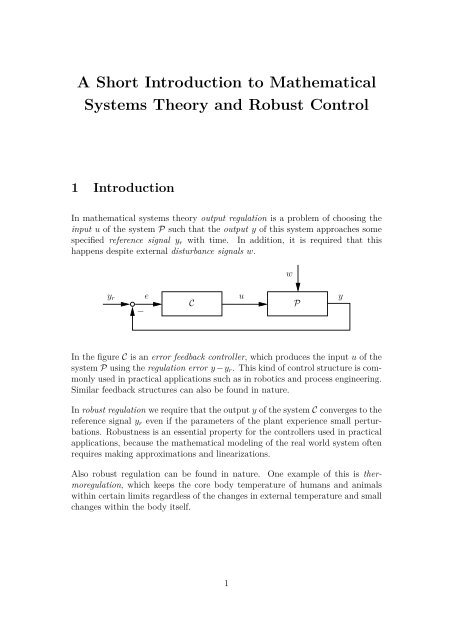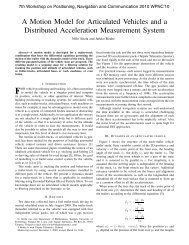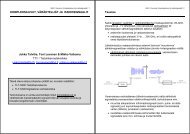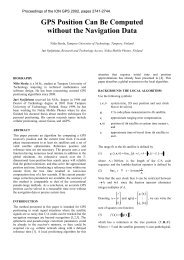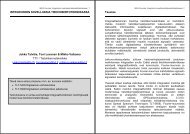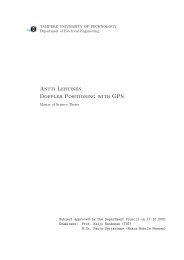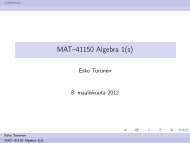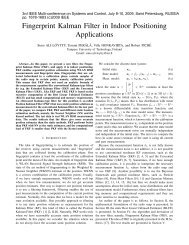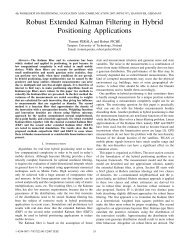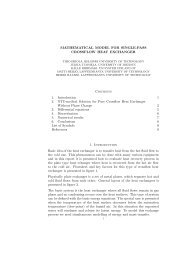A Short Introduction to Mathematical Systems Theory and Robust ...
A Short Introduction to Mathematical Systems Theory and Robust ...
A Short Introduction to Mathematical Systems Theory and Robust ...
You also want an ePaper? Increase the reach of your titles
YUMPU automatically turns print PDFs into web optimized ePapers that Google loves.
A <strong>Short</strong> <strong>Introduction</strong> <strong>to</strong> <strong>Mathematical</strong><br />
<strong>Systems</strong> <strong>Theory</strong> <strong>and</strong> <strong>Robust</strong> Control<br />
1 <strong>Introduction</strong><br />
In mathematical systems theory output regulation is a problem of choosing the<br />
input u of the system P such that the output y of this system approaches some<br />
specified reference signal yr with time. In addition, it is required that this<br />
happens despite external disturbance signals w.<br />
yr<br />
−<br />
e<br />
C<br />
In the figure C is an error feedback controller, which produces the input u of the<br />
system P using the regulation error y −yr. This kind of control structure is commonly<br />
used in practical applications such as in robotics <strong>and</strong> process engineering.<br />
Similar feedback structures can also be found in nature.<br />
In robust regulation we require that the output y of the system C converges <strong>to</strong> the<br />
reference signal yr even if the parameters of the plant experience small perturbations.<br />
<strong>Robust</strong>ness is an essential property for the controllers used in practical<br />
applications, because the mathematical modeling of the real world system often<br />
requires making approximations <strong>and</strong> linearizations.<br />
Also robust regulation can be found in nature. One example of this is thermoregulation,<br />
which keeps the core body temperature of humans <strong>and</strong> animals<br />
within certain limits regardless of the changes in external temperature <strong>and</strong> small<br />
changes within the body itself.<br />
1<br />
u<br />
w<br />
P<br />
y
2 ROBUST OUTPUT REGULATION PROBLEM 2<br />
2 <strong>Robust</strong> Output Regulation Problem<br />
Linear control theory considers the control of systems described by equations<br />
˙x(t) = Ax(t) + Bu(t) + ws(t), x(0) = x0 (1a)<br />
y(t) = Cx(t) + Du(t) + wm(t) (1b)<br />
Here x, u <strong>and</strong> y are called the state, the input <strong>and</strong> the output of the system,<br />
respectively. The equation (1a) is an abstract differential equation on a Banach<br />
space X <strong>and</strong> u(t) ∈ U, ws(t) ∈ X, wm(t) ∈ Y <strong>and</strong> y(t) ∈ Y for all times<br />
t ≥ 0, <strong>and</strong> W, U <strong>and</strong> Y are Hilbert spaces. We assume that the linear opera<strong>to</strong>r<br />
A : D(A) ⊂ X → X generates a strongly continuous semigroup [2] on X <strong>and</strong> the<br />
rest of the opera<strong>to</strong>rs are bounded <strong>and</strong> linear such that B ∈ L(U, X), C ∈ L(X, Y )<br />
<strong>and</strong> D ∈ L(U, Y ).<br />
In finite-dimensional control theory the state space X is an n-dimensional linear<br />
space C n <strong>and</strong> the opera<strong>to</strong>rs A, B, C <strong>and</strong> D are matrices of appropriate<br />
dimensions. In this case equation (1a) is a system of ordinary differential equations.<br />
Infinite-dimensional state spaces allow us <strong>to</strong> consider more general systems.<br />
These include systems which are described by delay equations <strong>and</strong> partial<br />
differential equations. A more detailed introduction <strong>to</strong> the properties of infinitedimensional<br />
systems can be found for example in [2].<br />
The reference <strong>and</strong> disturbance signals are assumed <strong>to</strong> be generated by an exosystem<br />
of form<br />
˙v(t) = Sv(t), v(0) = v0 (2)<br />
yr(t) = Frv(t)<br />
ws(t) = Esv(t)<br />
wm(t) = Emv(t).<br />
Here (2) is an abstract differential equation on a Hilbert space W . We assume<br />
S generates a strongly continuous group on W <strong>and</strong> that Fr, Es <strong>and</strong> Em are<br />
bounded linear opera<strong>to</strong>rs.<br />
The error feedback controller is described by equations<br />
˙z(t) = G1z(t) + G2(y(t) − yr(t)), z(0) = z0 (3a)<br />
u(t) = Kz(t), (3b)<br />
where (3a) is an abstract differential equation on a Banach space Z, the linear<br />
opera<strong>to</strong>r G1 : D(G1) ⊂ Z → Z generates a strongly continuous semigroup on Z,<br />
G2 ∈ L(Y, Z) <strong>and</strong> K ∈ L(Z, U).<br />
The output regulation problem can now be stated as follows:
3 CURRENT RESEARCH TOPICS 3<br />
Definition 1 (Output Regulation Problem (ORP)). Choose controller parameters<br />
(G1, G2, K) such that for all initial states x0 ∈ X, v0 ∈ W <strong>and</strong> z0 ∈ Z the<br />
output y(t) of the system (1) approaches yr(t) asymp<strong>to</strong>tically, i.e.<br />
<br />
lim<br />
t→∞ y(t) − yr(t)Y = 0. (4)<br />
In the problem of <strong>Robust</strong> Output Regulation we attempt <strong>to</strong> choose the controller<br />
parameters in such a way that the output regulation property (4) holds even if the<br />
opera<strong>to</strong>rs A, B, C, D, Es, Em, Fr are replaced by opera<strong>to</strong>rs A ′ , B ′ , C ′ , D ′ , E ′ s, E ′ m, F ′ r.<br />
A more detailed formulation of the <strong>Robust</strong> Output Regulation Problem can be<br />
found for example in [3] or in the finite-dimensional case in [5, Chap. 1].<br />
For more information on the properties of infinite-dimensional linear systems,<br />
Output Regulation <strong>and</strong> <strong>Robust</strong> Output Regulation, see for example [2, 1, 3]<br />
3 Current Research Topics<br />
In this section we outline some of our current research <strong>to</strong>pics.<br />
3.1 <strong>Robust</strong> Output Regulation for Infinite-Dimensional<br />
Exosystems<br />
One of our current research <strong>to</strong>pics is generalizing the state space theory of robust<br />
output regulation of infinite-dimensional systems for more general classes of<br />
disturbance <strong>and</strong> reference signals. Even when considering the control of infinitedimensional<br />
systems, the exosystem is most commonly assumed <strong>to</strong> be finitedimensional.<br />
These exosystems are able <strong>to</strong> generate signals which are linear<br />
combinations of signals of form<br />
t ↦→ t k e iωnt ,<br />
where k ∈ N0, ωn ∈ R. If we allow the signal genera<strong>to</strong>r <strong>to</strong> be infinite-dimensional<br />
we are able <strong>to</strong> study robust regulation of classes of bounded uniformly continuous<br />
signals. These include, for example, almost periodic signals. These are functions<br />
which can be uniformly approximated by trigonometric polynomials (i.e. functions<br />
of form pN(t) = N n=1 ane iωnt ). An example of an almost periodic function<br />
is<br />
f(t) = sin(t) + sin( √ 2t).
3 CURRENT RESEARCH TOPICS 4<br />
This generalization gives rise <strong>to</strong> many interesting problems. For example, it<br />
is usually required that the asymp<strong>to</strong>tic convergence of the output y <strong>to</strong> yr is<br />
exponentially fast. This is always the case if the system is finite-dimensional <strong>and</strong><br />
also possible under reasonable assumptions if the exosystem is finite-dimensional.<br />
However, if the signal genera<strong>to</strong>r is infinite-dimensional this can be impossible <strong>to</strong><br />
achieve. Because of this, we need <strong>to</strong> consider strong convergence of the output<br />
instead of exponential convergence.<br />
Most recent results on this <strong>to</strong>pic can be found in [3, 4].<br />
3.2 The Internal Model Principle <strong>and</strong> Infinite-Dimensional<br />
Sylvester Equations<br />
One of the most important results in classical control theory is the Internal<br />
Model Principle. This result states that a feedback controller C solving the<br />
robust output regulation problem necessarily contains a copy of the dynamics of<br />
the exosystem producing the considered reference <strong>and</strong> disturbance signals. One<br />
of the current research <strong>to</strong>pics is the generalization of the Internal Model Principle<br />
for infinite-dimensional systems <strong>and</strong> infinite-dimensional exosystems.<br />
This problem is also closely related <strong>to</strong> the study of certain infinite-dimensional<br />
Sylvester-equations. In particular the so-called regula<strong>to</strong>r equations<br />
ΣS = AeΣ + Be<br />
0 = CeΣ + De<br />
(5a)<br />
(5b)<br />
are important because it can be shown that the output regulation problem has<br />
a solution whenever the equations (5) have a solution Σ. Here S is the opera<strong>to</strong>r<br />
from the exosystem (2) <strong>and</strong> Ae, Be, Ce <strong>and</strong> De are opera<strong>to</strong>rs from the closed-loop<br />
system which describes the joint behaviour of the system P <strong>and</strong> the controller C.<br />
Most recent results on this <strong>to</strong>pic can be found in [11, 9, 10, 8].<br />
3.3 Infinite Zeros of Distributed Parameter <strong>Systems</strong> <strong>and</strong><br />
The Solvability of the Output Regulation Problem<br />
Most recent results on this <strong>to</strong>pic can be found in [6, 7].
REFERENCES 5<br />
References<br />
[1] C. Byrnes, I. Laukó, D. Gilliam, <strong>and</strong> V. Shubov. Output regulation problem<br />
for linear distributed parameter systems. IEEE Trans. Au<strong>to</strong>mat. Control,<br />
45(12):2236–2252, 2000.<br />
[2] Ruth F. Curtain <strong>and</strong> Hans J. Zwart. An <strong>Introduction</strong> <strong>to</strong> Infinite-Dimensional<br />
Linear <strong>Systems</strong> <strong>Theory</strong>. Springer-Verlag, New York, 1995.<br />
[3] Timo Hämäläinen <strong>and</strong> Seppo Pohjolainen. <strong>Robust</strong> regulation of infinitedimensional<br />
systems with infinite-dimensional exosystems. In Proceedings<br />
of the 17th IFAC World Congress 2008, pages 8749–8754, July 6–11, 2008.<br />
[4] Timo Hämäläinen <strong>and</strong> Seppo Pohjolainen. <strong>Robust</strong> regulation of distributed<br />
parameter systems with infinite-dimensional exosystems. SIAM J. Control<br />
Optim., Submitted.<br />
[5] Jie Huang. Nonlinear Output Regulation, <strong>Theory</strong> <strong>and</strong> Applications. SIAM,<br />
Philadelphia, 2004.<br />
[6] Eero Immonen <strong>and</strong> Seppo Pohjolainen. What periodic signals can an exponentially<br />
stabilizable linear feedforward control system asymp<strong>to</strong>tically<br />
track? SIAM J. Control Optim., 44(6):2253–2268, 2006.<br />
[7] Petteri Laakkonen <strong>and</strong> Seppo Pohjolainen. Finite <strong>and</strong> infinite transmission<br />
zeros for infinite-dimensional systems. In Proceedings of the IFAC Workshop<br />
on Control Applications of Optimisation, May 6–8, 2009.<br />
[8] L. Paunonen <strong>and</strong> S. Pohjolainen. Internal model theory for distributed<br />
parameter systems. SIAM J. Control Optim., Submitted.<br />
[9] L. Paunonen, S. Pohjolainen, <strong>and</strong> T. Hämäläinen. On infinite-dimensional<br />
Sylvester equation <strong>and</strong> the internal model principle. In Proceedings of the<br />
<strong>Mathematical</strong> <strong>Theory</strong> of Networks <strong>and</strong> <strong>Systems</strong> 2008, July 28 – August 1,<br />
2008.<br />
[10] Lassi Paunonen <strong>and</strong> Seppo Pohjolainen. On decomposing of infinitedimensional<br />
Sylvester equations. In Proceedings of the European Control<br />
Conference 2009, August 23–26, 2009.<br />
[11] Seppo A. Pohjolainen <strong>and</strong> Timo T. Hämäläinen. <strong>Robust</strong> regulation for<br />
infinite-dimensional systems. In Proceedings of the European Control Conference<br />
2007, Kos, Greece, July 2–5, 2007.


